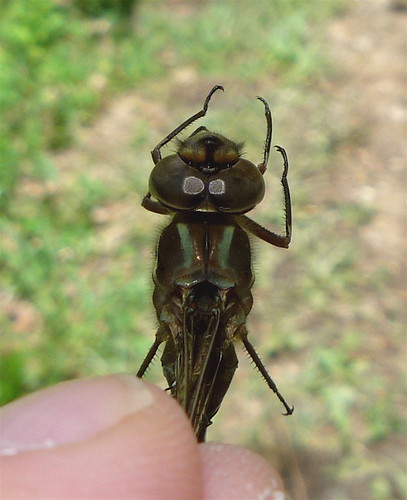The end of May-2010 had many warm, sunny days and I knew this species would be flying.
On May 29th, I began my search around 9:30am at the end of a little holler and found a female perched in dappled morning light. Unfortunately, the lighting didn't permit a reasonable photo with my point-and-shoot camera and the perch was in a tough location to net her (brambles and thick branches). I called Nannothemis encouraging her to come with her good camera, and, hopefully a great shot. Of course, the bugger didn't cooperate.
While searching the rivulet, a patrolling male was observed. It is amazing how these odes "appear" and "disappear" directly in front of you due to the dappled light and their light and dark dorsal pattern. The lighting was poor once again for a photo and obtaining one in flight is near impossible for me.

Every time I walk this small waterway, I search for exuviae. Surprise, I found three!
It's amazing how well the exuviae blend in with the trunks and if one isn't looking from the proper angle, they are nearly invisible.
The photo below shows one exuvia on a tree trunk and a second exuvia is present on the tree trunk in the background. The rivulet shows in the "distance":
 This is the second exuvia of a female:
This is the second exuvia of a female:
How did I know it was a female? The underside shows where the ovipositor develops on abdominal segment 9. Here is a ventral view:
 Here is a close-up of the ovipositor (the small, dark triangle):
Here is a close-up of the ovipositor (the small, dark triangle):
...and, finally, the third exuvia that blended in very well with the flaky bark:

This third exuvia was found on the trunk of the tree in the left of this image:

On May 30th, I stopped by hoping for better opportunities around 10am to observe this large dragonfly and was immediately rewarded with a male perched at the "magic spot".

However, I wasn't pleased with the lighting or the image due to my attempt at digiscoping this individual through my binoculars. I continued my search up the holler and came up empty so I returned to the "magic spot" and found two males. I finally had my chance for photos in the hand:
 Head shot showing how the eyes are teardrop-shaped and nearly touch in the center:
Head shot showing how the eyes are teardrop-shaped and nearly touch in the center:
Close-up of the thorax:
 Close-up of the claspers:
Close-up of the claspers:
Dorsal view of the abdomen, showing its namesake:

Hasta luego:


























